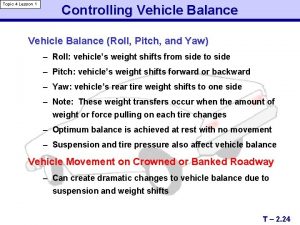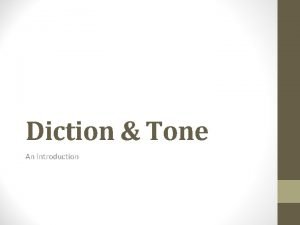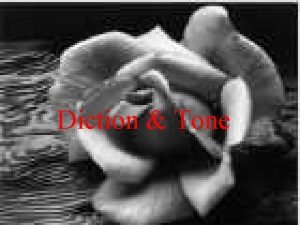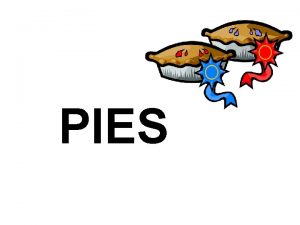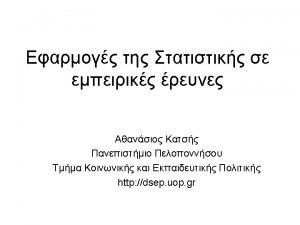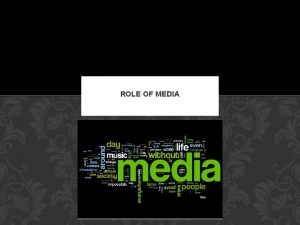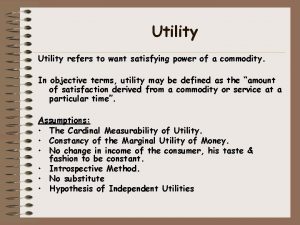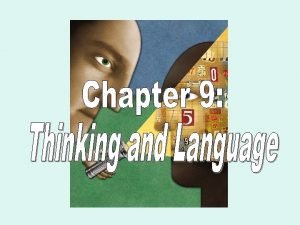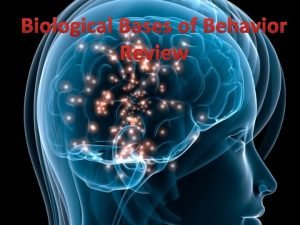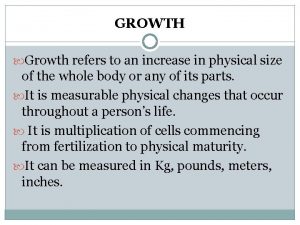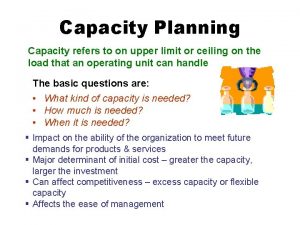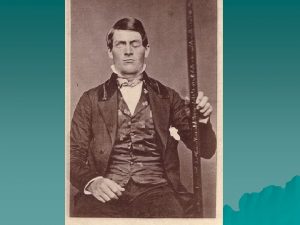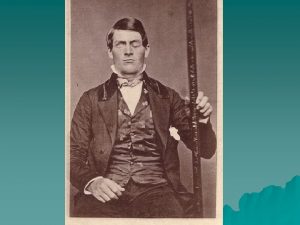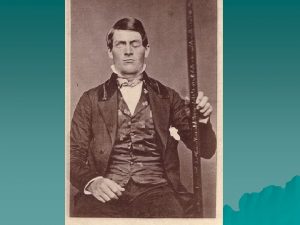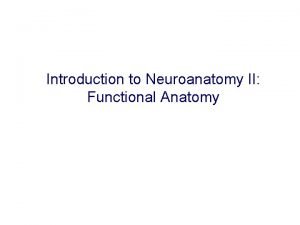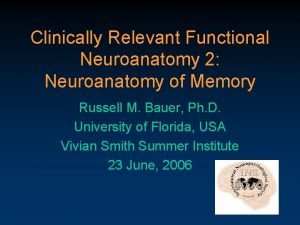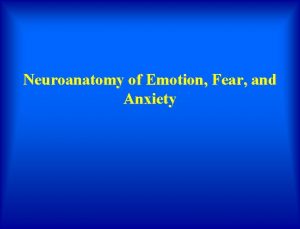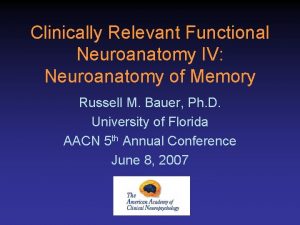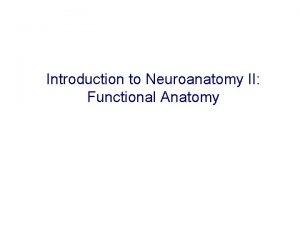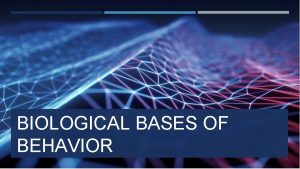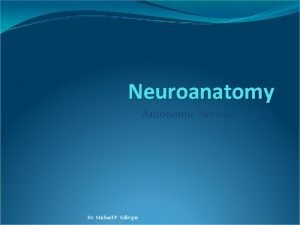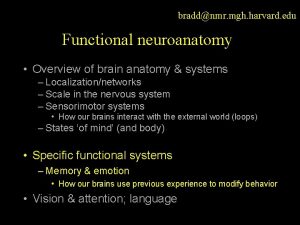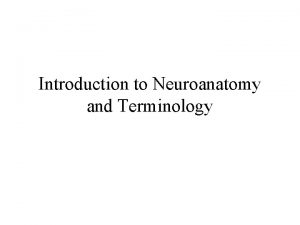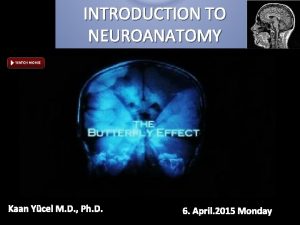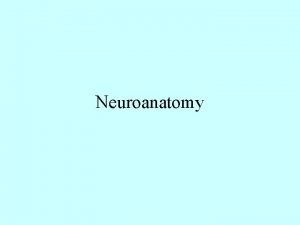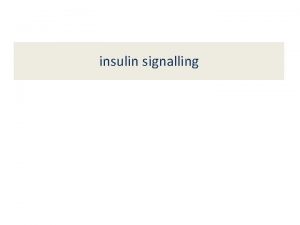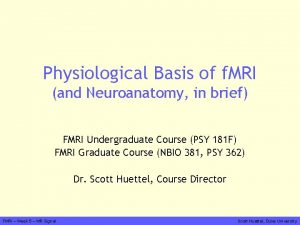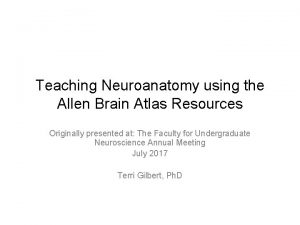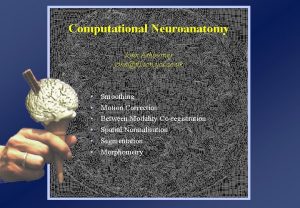Neuroanatomy u Neuroanatomy refers to the study of

































































- Slides: 65


Neuroanatomy

u. Neuroanatomy refers to the study of the parts and function of neurons. u. Neurons are individual nerve cells. u. The entirety of the human body’s neurons make up the nervous system, from the brain to the tips of the toes.

The Basic Parts of a Neuron

u. A. Dendrites – Thin, branching fibers lined with receptors at which the dendrite receives information from other neurons. The greater the surface area, the greater the amount of information. Some dendrites are covered with spines which greatly increase its surface area.

u. B. Cell Body/Soma –Contains the (C) nucleus and other parts of the cell needed to sustain life

u. D. Axon –Wire-like structure ending in the terminal buttons that extends from the cell body

u E. Myelin Sheath – An insulating, fatty covering around the axon that speeds neural transmissions. Axons that are myelinated appear white. Known as “white matter. ”

F. Schwann Cells u Provide sheath. for the growth of the myelin

u G. Nodes of Ranvier – Regularly spaced gaps in the myelin sheath around an axon or nerve fiber. This is where depolarization takes place.

u. H. Terminal Buttons –The branched end of the axon that contains neurotransmitters

Neural Transmission

u. Synapse –The space between the terminal buttons on one neuron and dendrites of the next neuron

Neurotransmitters Chemicals contained in the terminal buttons that enable neurons to communicate. Neurotransmitters fit into receptor sites on the dendrites of neurons like a key fits into a lock.


Neurotransmitters

u At the terminal buttons, neurotransmitters are released into the synapse and passed along to the dendrites of the next neuron.

u. If enough neurotransmitters have been sent, the next neuron will fire. If not, the message ends. This is called the all-or-nothing principle.



u After a neuron fires its message, there is a brief period of time before it can fire again. This is called a neuron’s refractory period. u During the refractory period, excess neurotransmitters are reabsorbed by the sending neuron, called re-uptake, as well as the cell becoming polarized once again.

u In its resting state (resting potential or polarization), a neuron has a negative charge because mostly negative ions are within the cell. Surrounding the cell are positively charged ions. The ions cannot mix because it its resting stage, the cell membrane is semi-impermeable.

u. A neuron has a pre-set level of stimulation that needs to be met or exceeded in order for it to pass the received impulses on to the next neuron. This is called a neuron’s threshold.

u If the threshold has been met or exceeded, a chain reaction begins. u With threshold being met, the cell becomes depolarized and allows positively charged ions into the axon at the nodes of ranvier. This mix of positive and negative ions causes an electrical charge to form (an action potential). At 120 meters per second, the action potential travels to the terminal buttons.


Axon – inside and out

Resting Potential u The state of a neuron when it is at rest and capable of generating an action potential u The neuron is set and ready to fire

Action Potential u A brief electrical charge that travels down the axon of the neuron. u A neural impulse u Considered an “on” condition of the neuron

Refractory Period u. The “recharging phase” when a neuron, after firing, cannot generate another action potential u. Once the refractory period is complete the neuron can fire again




Neuron firing like a Toilet 1. Like a Neuron, a toilet has an action potential. When you flush, an “impulse” is sent down the sewer pipe

Neuron firing like a Toilet 2. Like a neuron, a toilet has a refractory period. There is a short delay after flushing when the toilet cannot be flushed again because the tank is being refilled

Neuron firing like a Toilet 3. 4. Like a Neuron, a toilet has a resting potential. The toilet is “charged” when there is water in the tank and it is capable of being flushed again Like a Neuron, a toilet operates on the all-or-none principle – it always flushes with the same intensity, no matter how much force you apply to the handle

All-or-None Principle u. The principle that if a neuron fires it will always fire at the same intensity u. All action potentials are of the same strength. u. A neuron does NOT fire at 30%, 45% or 90% but at 100% each time


Click here to see a neuron in action!

u. Depending on what type of neurotransmitter has been released, the next neuron will react differently. …. so, since the entire body is a connection of nerves, …

Acetylcholine (ACh) u. Enables muscle action, learning, and memory u. Undersupply, as AChproducing neurons deteriorate, marks Alzheimer’s disease

u. Reward Dopamine and Motivation, Motor Control over Voluntary Movements u. Excessive dopamine linked to schizophrenia; a lack of dopamine produces the tremors and lack of mobility (like in Parkinson’s disease)

u. Affects Serotonin mood, hunger, sleep, and arousal u. Undersupply is linked to depression; Prozac and other anti-depressants raise serotonin levels

Norepinephrine u. Helps to control alertness and arousal u. Undersupply can depress mood

GABA u. Muscular movement u. Undersupply linked to seizures, tremors, and insomnia

Glutamate u. Involved in memory u. Oversupply can overstimulate the brain, producing migraines or seizures

Endorphins u. Natural opiates that are released in response to pain and vigorous exercise

Epinephrine u. Adrenaline Burst of Energy (small amounts in brain)

Drugs and Chemical Interactions with Neural Transmission

u. Some drugs that people put into their bodies are classified as agonists. u. Agonists may either speed up the neural process, cause an over-release or absorption of a neurotransmitter, or block the re-uptake process.

Prozac blocking the re-uptake of Serotonin

u Some agonists mimic the effects of a naturally occurring neurotransmitter Agonist (like morphine – replacing natural endorphines) Dendrite of receiving Neuron

u. After a neuron fires, if reuptake is blocked, the lingering neurotransmitters in the synapse will continue to be absorbed by the receiving neuron until it is gone. u. Therefore, a lingering feeling will occur

Examples of Agonists u. Cocaine – blocks the reuptake of dopamine u. MDMA (Ecstasy) – blocks the reuptake of serotonin –Repeated use destroys serotonin producing cells

u. Some drugs that people put into their bodies are classified as antagonists. u. Antagonists may slow or stop the transmission of a neurotransmitter, or they may bind themselves to receptors on a neuron’s dendrite, thus not allowing a message to be passed on.

Examples of Antagonists u Curare – a poison that stops the flow of Ach – causes paralysis Antagonist (like curare) Neurotransmitter (such as Ach) Dendrite of receiving Neuron

Types of Neurons u. There are three types of neurons: –Afferent Neurons (Sensory Neurons) –Interneurons –Efferent Neurons) (Motor

u. Afferent Neurons are responsible for taking information from the senses TO the brain.

u. Interneurons are located in the spinal cord and the brain. u. Interneurons in the brain are responsible for sending messages along to the various areas of the brain for processing.

u. Efferent Neurons responsible for taking information FROM the brain and the spinal cord, and back to the rest of the body.

u. The exceptions to the “general pathway” of neural activity are reflexes.

• Reflexes are controlled by the spinal cord without any conscious effort on behalf of the brain.

u. Reflexes are primitive responses uprotect our bodies from danger

We cough, for example, when an irritant enters our windpipe and we need to expel it through our mouth. We sneeze when we need to clear our nasal air passages of irritants and allergens. We blink when danger threatens the sensitive tissues of the eye and when we need to moisten and clean the cornea. (This reflex occurs 900 times an hour!) We yawn when nerves in the brain stem find there's too much carbon dioxide in the blood. Reflex

Reflex Spinal Cord

 Chúa yêu trần thế
Chúa yêu trần thế Phối cảnh
Phối cảnh Một số thể thơ truyền thống
Một số thể thơ truyền thống Sơ đồ cơ thể người
Sơ đồ cơ thể người Tư thế ngồi viết
Tư thế ngồi viết Cong thức tính động năng
Cong thức tính động năng Các số nguyên tố
Các số nguyên tố đặc điểm cơ thể của người tối cổ
đặc điểm cơ thể của người tối cổ Tỉ lệ cơ thể trẻ em
Tỉ lệ cơ thể trẻ em Các châu lục và đại dương trên thế giới
Các châu lục và đại dương trên thế giới độ dài liên kết
độ dài liên kết ưu thế lai là gì
ưu thế lai là gì Môn thể thao bắt đầu bằng chữ f
Môn thể thao bắt đầu bằng chữ f Thẻ vin
Thẻ vin Hát kết hợp bộ gõ cơ thể
Hát kết hợp bộ gõ cơ thể Bàn tay mà dây bẩn
Bàn tay mà dây bẩn Từ ngữ thể hiện lòng nhân hậu
Từ ngữ thể hiện lòng nhân hậu Trời xanh đây là của chúng ta thể thơ
Trời xanh đây là của chúng ta thể thơ Tư thế ngồi viết
Tư thế ngồi viết V cc cc
V cc cc Voi kéo gỗ như thế nào
Voi kéo gỗ như thế nào Thể thơ truyền thống
Thể thơ truyền thống Khi nào hổ mẹ dạy hổ con săn mồi
Khi nào hổ mẹ dạy hổ con săn mồi đại từ thay thế
đại từ thay thế Thế nào là hệ số cao nhất
Thế nào là hệ số cao nhất Diễn thế sinh thái là
Diễn thế sinh thái là Vẽ hình chiếu vuông góc của vật thể sau
Vẽ hình chiếu vuông góc của vật thể sau Lp html
Lp html Thế nào là mạng điện lắp đặt kiểu nổi
Thế nào là mạng điện lắp đặt kiểu nổi Mật thư anh em như thể tay chân
Mật thư anh em như thể tay chân Lời thề hippocrates
Lời thề hippocrates Vẽ hình chiếu đứng bằng cạnh của vật thể
Vẽ hình chiếu đứng bằng cạnh của vật thể Chụp phim tư thế worms-breton
Chụp phim tư thế worms-breton Quá trình desamine hóa có thể tạo ra
Quá trình desamine hóa có thể tạo ra Sự nuôi và dạy con của hươu
Sự nuôi và dạy con của hươu điện thế nghỉ
điện thế nghỉ Các châu lục và đại dương trên thế giới
Các châu lục và đại dương trên thế giới Dạng đột biến một nhiễm là
Dạng đột biến một nhiễm là Biện pháp chống mỏi cơ
Biện pháp chống mỏi cơ Bổ thể
Bổ thể Thiếu nhi thế giới liên hoan
Thiếu nhi thế giới liên hoan Làm thế nào để 102-1=99
Làm thế nào để 102-1=99 Retrospective cohort study vs prospective cohort study
Retrospective cohort study vs prospective cohort study In area
In area What is method study
What is method study Distinguish between time study and motion study
Distinguish between time study and motion study Distinguish between time study and motion study
Distinguish between time study and motion study What is case series
What is case series Marty lobdell
Marty lobdell Ecological theory of development
Ecological theory of development Vehicle balance definition
Vehicle balance definition Describing diction
Describing diction Prejudice nondiscriminator
Prejudice nondiscriminator Focal points are enclosed within the core
Focal points are enclosed within the core What is culture is cumulative
What is culture is cumulative Diction refers to
Diction refers to What are the ingredients and proportions in 3-2-1 dough?
What are the ingredients and proportions in 3-2-1 dough? Value added model education
Value added model education The media only refers to television
The media only refers to television Nine principles of design
Nine principles of design Want satisfying power of a commodity
Want satisfying power of a commodity Cognition refers to
Cognition refers to Brain lateralization refers to the ap psych
Brain lateralization refers to the ap psych Growth refers to
Growth refers to Capacity refers to the upper limit of:
Capacity refers to the upper limit of: Diversity refers to:
Diversity refers to:


















































